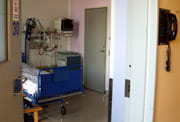Printed from acutecaretesting.org
October 2003
Are we ready for the outbreak of an epidemic?
acutecaretesting.org: Why was Hvidovre Hospital chosen to be one of the key sites in Denmark for treating SARS patients?
Dr Jens Ole Nielsen: Three factors were considered: our location, our ability to isolate patients, and our experience with infectious diseases. Hvidovre is a town close to the country's capital, Copenhagen.
In other words, we could cover a densely populated area without being right at the center of it. At the same time, Hvidovre is near the Copenhagen Airport, which was also important, as most SARS patients were being transported directly from airports to hospitals. We were also chosen for our ability to isolate infectious patients, an ability which not all hospitals possess. Hvidovre is also one of five hospitals in Denmark that have a department of infectious diseases.
 Dr Jens Ole Nielsen
Dr Jens Ole Nielsen
acutecaretesting.org: What considerations did the appointment trigger in your department?
Dr Jens Ole Nielsen: There were many practical considerations as to how and where we could place SARS patients, and what kind of equipment we would need to diagnose and treat the disease. But if I had to point out a major consideration, I'd say it was staff safety.
In Toronto, nearly 59 % of SARS-infected patients were healthcare professionals that had been infected by patients. That was something we wanted to avoid at all costs.
acutecaretesting.org: What was the next step?
Dr Jens Ole Nielsen: Once we raised all these questions, we decided to make a plan of action.
acutecaretesting.org: What were the milestones?
Dr Jens Ole Nielsen: Contacting all of our colleagues in the other departments of biochemistry, microbiology, anesthesia, intensive care, and X-ray to establish which equipment and procedures we would need to have in place to properly receive a SARS-patient.
The next step was getting the equipment: a blood gas analyzer, ventilators, masks, protective gowns... Once the equipment was in place, we began describing internal procedures. Finally, we moved on to practical exercises.
acutecaretesting.org: What were these practical exercises?
Dr Jens Ole Nielsen: We would basically follow a fictitious patient from the time the patient came to us in an ambulance to placing him in an isolation unit and connecting him to the ventilator.
 Isolation Unit
Isolation Unit
acutecaretesting.org: A blood gas analyzer is among the equipment you have in place. Why is that?
Dr Jens Ole Nielsen: SARS is a respiratory syndrome, so we need to measure blood gases in order to determine oxygen status of incoming patients as well as of the patients on the ventilator.
acutecaretesting.org: Is it necessary to run more blood gas tests on SARS patients compared with other critically ill patients?
Dr Jens Ole Nielsen: Yes. SARS is primarily a lung disease. Respiratory distress is the main cause of death. To avoid that, we need to constantly monitor oxygen levels in the blood. If a patient begins to show signs of respiratory distress, he must be connected to a ventilator.
acutecaretesting.org: Is blood gas the most important parameter to measure in SARS patients?
Dr Jens Ole Nielsen: Yes. We also measure common clinical parameters such as electrolytes, blood pressure, diuresis, and heart rate.
acutecaretesting.org: Where is the analyzer placed?
Dr Jens Olsen: The analyzer is placed at the point of care near the isolation units. We have then connected the analyzer to a data management software. The results are sent to a central observation room, so we can follow how each patient is progressing. In the future, results will be sent to the central lab as well.
acutecaretesting.org: Why use a data management software to send the results to an observation room?
Dr Jens Ole Nielsen: Safety. A key element in treating any patient suffering from an infectious disease is to keep him as isolated as possible. Under normal circumstances, a nurse or doctor will enter and leave a patient's room many times a day. With SARS, or any other infectious disease for that matter, the goal is to minimize contact as much as possible to avoid further contamination.
acutecaretesting.org: How far along are you in the process?
Dr Jens Ole Nielsen: Right now, we have six beds for patients with highly infectious diseases. The architects are in the process of drawing the new department that will accommodate 30 patients. If funded, we expect the new installations to be ready by the beginning of 2004.
acutecaretesting.org: What have been the main challenges so far?
Dr Jens Ole Nielsen: There have been both upstream and downstream challenges. The upstream challenge was to convince Danish politicians that SARS is not some faraway problem, but something that could happen in Denmark as well. That was important so we could get the necessary funds to prepare ourselves for a possible epidemic.
acutecaretesting.org: What about the downstream challenges?
Dr Jens Ole Nielsen: Facing the fear among our staff. People want to work here, but they also want to be sure that nothing bad will happen to them. We could not guarantee that no staff would be infected. No one can. But we can do everything in our power to prevent that from happening.
acutecaretesting.org: How did you overcome these challenges?
Dr Jens Ole Nielsen: The World Health Organization (WHO) was a big help. The government could easily have ignored the problem, if it were not for WHO's global warning. It was the first time in many years the organization sent out a global warning, and that made people aware of the seriousness of the situation. Once the warning was out, the Danish Board of Health organized a SARS task force to consider the national risks.
acutecaretesting.org: What about the staff's fear of being infected?
Dr Jens Ole Nielsen: We took their fears very seriously. Back in the 80s, when we got our first AIDS patients, some of our nurses quit, because they were afraid of being infected.
To avoid that, we were very frank about the risks involved, but also about what we were going to do to avoid staff getting infected. Being open about it helped ease people's fears. We have also trained all the procedures very intensively with the staff. The goal is to prepare them as much as possible for a real-life epidemic. The more people feel prepared to deal with a situation, the less fearful they become.
acutecaretesting.org: How much did you rely on an exchange of information with other hospitals while reorganizing your setup?
Dr Jens Ole Nielsen: Very much. Hospitals have in general been very open about sharing information - both success stories and failures. In the end of September, I attended an international conference in Chicago.
There was a presentation from Toronto, where they were open about the fact that spreading all SARS patients into different hospitals instead of having them isolated in key locations had been a failure. Thanks to the information shared by other hospitals, we have learned about the importance of wearing masks and protective gowns and the need for patient intubation and ventilation.
Not to mention the need for anesthesia before intubating patients to prevent coughing and the spread of aerosol. All of this is valuable information, which we are incorporating in our setup.
acutecaretesting.org: Is the threat of SARS completely over?
Dr Jens Ole Nielsen: The last reported case of SARS was on September 17, 2003 - a laboratory case in Singapore. However, the experts at the Chicago conference expect some cases of SARS as winter approaches, which is the period where respiratory diseases increase. So we want to be prepared for that.
acutecaretesting.org: Is SARS the only infectious disease we need to be prepared for?
Dr Jens Ole Nielsen: The anthrax threat after September 11 has taught us that infectious diseases come in many forms. I still remember when the American Surgeon General said that with antibiotics and vaccines, it was time to close the book on infectious diseases.
Ironically, since then, we have identified nearly 40 new infectious diseases. I believe that we will see the re-emergence of old diseases, as well as the emergence of new ones. Our current agricultural system facilitates the interaction of human and animal viruses, creating an ideal situation for the emergence of a new virus. In a way, you can say that the microbes are fighting back.
acutecaretesting.org: What is your advice to hospitals wishing to prepare themselves for an epidemic?
Dr Jens Ole Nielsen: The SARS threat is not over yet. What we have now is some time to reflect and learn from our experiences so far and prepare ourselves. My advice is to start with the practical aspects. Find out what equipment you will need and where you will place the patients.
Not all hospitals offer the possibility of isolating patients, and that is something you need to have when treating patients with infectious diseases. Then describe all procedures - from transporting the patient from the local airport or another hospital to connecting him to a ventilator and taking blood gas samples.
Get all the details listed. Then train staff in the procedures until they feel comfortable and prepared to deal with a real-life situation. Again, the more trained they are, the more ready they will feel to face an epidemic.
|
About SARS SARS stands for Severe Acute Respiratory Syndrome. According to the World Health Organization (WHO), the main symptoms of SARS are high fever (> 38 °C/100 °F), dry cough, shortness of breath, or breathing difficulties. Although SARS is contagious, close contact with an infected person is needed for the infective agent to spread from one person to another. Based on WHO statistics from September 26, 2003, there have been a total of 8,098 cases of SARS around the world, resulting in 774 deaths. For more information, go to WHO's SARS site at http://www.who.int/csr/sars/en/. Read also the article "The SARS epidemic: lessons for Australia" on the site for The Medical Journal of Australia. http://www.mja.com.au/public/rop/cam10220_fm.html |
Interviewer
Ana Johansson
Radiometer Medical A/S
Åkandevej 21
2700 Brønshøj
Denmark
Acute care testing handbook
Get the acute care testing handbook
Your practical guide to critical parameters in acute care testing.
Download nowScientific webinars
Check out the list of webinars
Radiometer and acutecaretesting.org present free educational webinars on topics surrounding acute care testing presented by international experts.
Go to webinars








